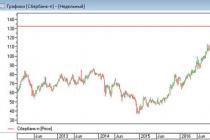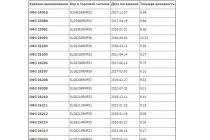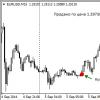Immigrants may have a more difficult time due to a lack of credit history. The fact that there is high competition between banking institutions plays to your advantage. In case of refusal, you can always go across the road and open an account in another bank.
Most often, the first year of service is free - this is done in order to attract new customers. Don’t hesitate to visit 2-3 banks and find out the conditions; in the long run, this can save you significant money. Also consider the opening hours and the convenience of the branches’ location relative to your home or work. To open an account, you will need two original documents, such as a passport and a driver's license.
Major Canadian banks (RBC, BMO, TD, CIBC and Scotiabank) offer special rates for new immigrants. Don’t forget to look into them, you can often open an account on very attractive conditions.
Price
Keep in mind that each of these banks has mandatory monthly fees for checking accounts. The average Canadian spends about $220 a year on banking. Now you understand how profitable it is to take part in the “First year of service as a gift” promotion! Depending on the number of transactions, the bank charges from $5 to $30 for its services every month. These fees can be avoided by maintaining your balance above a certain level - $1000-$1500.
In Canada, people are accustomed to writing a check with the amount rather than handing over cash. In 90% of cases, you will have to pay rent this way. A 100-page checkbook will cost approximately $25-40.
There are often significant fees associated with using foreign bank cards, so you should open an account in Canada as quickly as possible.

ATMs
Just like in Russia, it is better to use “home” ATMs to withdraw cash. The fee for withdrawing cash from someone else's ATM (Automated Teller Machine) usually costs one and a half dollars, and if it is a private ATM, it is much more expensive - from $1.50 to $4.50, and maybe more. They should be avoided and used only in extreme cases.

Canada's Best Banks for Immigrants
- Vancouver: Free checking account available from Coast Capital Credit Union. You can use Coast Capital and HSBC ATMs to withdraw cash without fees.
- President's Choice online bank offers free account maintenance, an unlimited number of transactions, and free checkbooks. You can use the CIBC infrastructure to withdraw cash.
Maintaining an account at other banks will cost at least $4 per month, the possibility of free cash withdrawals is limited, and a checkbook costs from $25.

Credit cards
When choosing a bank, it would be a good idea to take a closer look at credit cards in the future. In addition to convenience, many banks offer profitable reward programs for purchases: free miles, discounts in hypermarkets, online stores, and so on. When analyzing, take into account the interest-free period, rate and additional fees, for example when withdrawing cash. From an early age, Canadians take care of their credit rating by paying off payments on time.
RBC Dexia issues credit cards without checking the borrower's history, which solves the problem of its absence. This option is only available to Canadian citizens and permanent residents. Scotiabank also offers a similar promotion for new immigrants.

Canada's credit system has a complex institutional structure, the creation of which was strongly influenced by the credit systems of the United States and Great Britain. These countries sought to strengthen their positions in Canada by mastering national sources of financing. Credit institutions arose back in the colonial period; the functions of bankers were performed by trading companies. Various branches of foreign credit institutions operated in Canada. The first commercial bank of Canada was formed in 1817 - the Bank of Montreal. Then a number of specialized institutions appear: insurance companies, trust and mortgage companies, etc.
The First World War had a strong impact on the strengthening of commercial banks, and after it non-banking institutions developed more rapidly: installment and consumer finance companies, insurance and trust companies.
World economic crisis of the 1930s. negatively affected the credit system, commercial banks, in particular, and other credit institutions. During this period, the Bank of Canada was created, government intervention in the credit system increased, and the activities of specialized government institutions for lending to housing construction and agriculture were intensified.
The improvement of the credit system continued during the Second World War and after it, new types of specialized credit institutions appeared: leasing companies, state insurance companies, pension companies.
The modern credit system of Canada includes: a central bank of issue, commercial banks, and specialized institutions. The central bank of issue - the Bank of Canada - is united. The number of commercial banks is small; Provincial-level credit institutions operate within the provinces. The country's credit system is characterized by the presence of the following main financial institutions: commercial, trust and mortgage banks, insurance and investment companies. Private commercial, or so-called charter banks, enjoy complete freedom in commercial activities. It is regulated by parliamentary charters. Chartered banks, by their purpose, are designed to serve the industrial, commercial and public sectors of the economy. They carry out deposit operations, provide various types of loans, and engage in foreign exchange transactions.
The Canadian Bankers Association, whose highest body is the executive board, is at the head of Canada's clearing system. The work of the settlement system between banks is directly headed by the so-called Committee of Clearing and Information Centers. It has 10 regional clearing houses, called settlement centers, organized by it. Regional clearing houses exist in Ottawa, Calgary, Halifax, Montreal, Quebec City, Regina, Saint John's, Toronto, Vancouver and Winnipeg. Their activities are directly administered by local clearing associations under mandates received from the Canadian Bankers Association.
There are other institutions in the credit system, or, as they are called in the country, “non-bank financial intermediaries” (NBFIs). They also handle banking operations. This category includes credit unions and cooperative financial institutions that primarily serve the French-speaking population. NBFPs are very heterogeneous. In addition to those indicated, these include independent trust banks and trust departments of commercial banks.
Like other leading capitalist countries, the insurance business is developed in Canada. There is a fairly high degree of concentration of insurance capital in the country. American companies have established themselves quite firmly in the local insurance market; Of the 172 foreign firms operating in Canada, 134 are from the United States. In turn, the American market is the main area of foreign expansion for Canadian insurers. There are 71 Canadian insurance companies in the US (7 in the UK, 6 in Hong Kong).
Central Bank of Canada (Bank of Canada)
The Bank of Canada is the country's central bank of issue. It was established as a joint stock company, but its shares could not be held by commercial banks and their employees, as well as foreigners. Government of Canada during 1935-1938 bought the shares they owned from private owners, thereby strengthening the Bank as a central bank. Its activities are determined by the federal government, which appoints a Board of Directors. The Board of Directors includes the Deputy Minister of Finance. The Bank of Canada systematically reports to Parliament on its activities.
The main functions of the Bank of Canada are: regulation of money circulation and credit; maintaining the exchange rate of the national currency against other currencies; mobilization of price levels, production levels and trade. The Bank of Canada issues banknotes into circulation, provides advances to commercial banks, manages cash reserves of commercial banks, regulates settlements between banks on clearing accounts, and regulates government gold and foreign exchange reserves.
The Bank of Canada is an agent of the federal government, manages government securities, its cash, and provides connections with the central banks of other countries. The Bank of Canada does not purchase shares of commercial banks and does not lend or accept deposits from individuals or companies.
The main place in the Bank of Canada's assets is occupied by investments in government bonds. It also carries out transactions with securities to place them on the open market, interest on which is the most important source of its income. The main liability item of the Bank of Canada is the banknotes it issues. Some of them end up in commercial banks as cash reserves. In addition, non-interest bearing deposits of commercial banks are also a reserve item. In addition, the Bank of Canada performs the function of a “bank of banks”, i.e. is a lender of last resort for commercial banks, to which it provides small short-term loans and makes small investments in foreign securities. Commercial banks, as lenders to the Bank of Canada, are required by law to hold their reserves with it. Deposits at the Bank of Canada are held by the Canadian government and major foreign central banks.
The main activities of the Bank of Canada were formed during the period of strengthening state-monopoly tendencies, which contributed to the strengthening of state regulation of the monetary system. This was especially evident in the post-war period, when the state moved to targeted counter-cyclical regulation of the economy. The Bank of Canada showed the greatest activity in regulating monetary circulation in the second half of the 1950s. The discount rate, which changed in 1944, 1950 and 1955, acted as a regulator of economic activity. ranging from 1.5 to 2.5%.
However, the low effectiveness of interest rate policy and its lack of flexibility forced the Bank of Canada to switch to operations with securities on the open market in its monetary regulation. The Bank of Canada first carried out such operations to save the Canadian dollar during the currency crisis of 1962. Currently, the policy of the Bank of Canada is a method for regulating the required reserve ratio of commercial banks. By changing them, the Bank of Canada increased or decreased the amount of money available to commercial banks for lending. In addition, since 1971, the Bank of Canada has set limits on the increase in the money supply in circulation. However, these measures do not always contribute to sufficient regulation of the economy.
Commercial banks of Canada
The main link in Canada's credit system is made up of private commercial, or privileged, banks. They have a huge impact on the structure of private investment and consumer spending in the country, lending to industrial, commercial and other enterprises.
During their existence, commercial banks have constantly concentrated, i.e. mergers and acquisitions took place, their numbers were reduced, but their financial power increased. Canada's banking legislation, modeled on England, facilitated the organization of large banks and their branches in the provinces, which allowed banks to maneuver funds in different geographical locations.
Commercial banks in Canada are depository banks, they discount bills of exchange, accept demand deposits, and open personal savings and time accounts for clients. They hold government and private corporation securities in their portfolio, provide loans to various companies and individuals, carry out currency transactions, and service export operations. Commercial banks issue credit cards and traveler's checks, provide services for storing valuables in special safes, and carry out operations for medium- and long-term rental of machinery and equipment. They have become large "financial services institutions."
The main type of active operations of commercial banks are lending operations. In the lending operations of banks, the main place is occupied by short-term lending to private enterprises, and recently the volume of loans for housing construction and installment purchases has been growing.
In industrial lending, there is a trend toward industry specialization, but recently the universalization of banking functions and the creation of banking consortiums to finance large industrial facilities have dominated. Commercial banks provide mainly short-term loans to exporters, and the state has taken over the function of long-term lending.
In the post-war period, the structure of commercial banks' investments in securities changed. For a long time, commercial banks preferred government bonds; later they began to evenly distribute their funds between government and corporate securities.
Savings accounts occupy a high share of the liabilities of commercial banks. From such deposits, banks receive the largest share of profit for lending operations. Deposits in foreign currency have expanded, which are used by banks to lend to foreign clients and to finance foreign trade transactions.
Recently, the network of branches of Canadian commercial banks in other countries has been expanding; the largest number of their branches, subsidiaries, and agencies have been opened in the USA, Great Britain, and the countries of the Near and Middle East. Essentially, commercial banks in Canada are turning into international credit institutions with their main offices located in Canada. Transnational banks primarily include the entire top five commercial banks of the country - Royal Bank of Canada, Canadian Imperial Bank of Commerce, Bank of Montreal, Bank of Nova Scotia, Toronto Dominion bank."
Other banking institutions
However, since the mid-1980s. The most striking manifestation of the undermining of the decades-old system of division of functions between the “four pillars” of Canadian finance and credit is the rapid expansion in the country of a completely new type of financial institution for Canada - a widely diversified investment banking firm, or, in the terminology of Canadian experts, a “merchant bank” "
The rapid development of this type of financial institutions is largely explained by the fact that a “merchant bank” practically does not fall under existing laws regulating the financial sector in Canada, and primarily under laws limiting the rights of depositors to buy large (over 10%) blocks of voting shares of financial institutions. companies. Thus, penetration into credit and financial markets through institutions of this kind is most beneficial to the largest groups of monopoly capital, which have the appropriate means to completely dispose of large organizations of “financial holdings” of such companies. They rely on the total financial and economic potential of all credit and financial institutions controlled by them, and use the already established network of their clientele, their knowledge of the market, management experience, etc.
Canada's first and largest investment banking firm was Heath International Corp. - part of the giant family estates of Edward and Peter Bronfman. Another example of a “merchant bank” is Central Capital Management Inc., which separated from the Central Capital Corp. holding company. His main holding is one of the largest Canadian trust companies, Central Trust. The entire group of financial institutions is controlled by two large Canadian businessmen R. Cohen and D. Ellen. Own “merchant bank” - Lancaster Financial Inc. organized by the financial conglomerate Crownex Inc. (its central link is the large insurance company Crown Life Insurance).
If in 1985 there was only one such institution in the country, then in 1988 there were already about one and a half dozen, and this number is constantly increasing. “Merchant banks” have spun off from literally all the largest diversified companies in the field of finance. The formation of financial conglomerates from financial companies of various specializations has become the most important feature of the centralization of capital in the credit and financial sector of Canada.
Savings banks in Canada are not as widespread as in the United States. They mainly develop in Quebec and are controlled by "family" groups of French-speaking capitalists. The population's funds are invested in government bonds.
Banking legislation played a major role in the development of the banking sector of Canadian financial capital. Special studies conducted in Canada have convincingly shown that the country's banking system has always been reliably protected both from competition from other financial industries and from financial institutions under foreign control. As a result of such protection, banks were able to extract monopoly high profits.
The apparatus of administrative regulation (regulation) of various industries and spheres of the country’s economy is also widely used by Canada’s financial capital in its own interests. First of all, this relates to the regulation of the securities market (stocks and bonds) of corporations. Thus, a number of special acts regulating the securities market (this area is under the jurisdiction of the provinces) complements the action of tax laws in the direction of further concentration and centralization of capital in the country.
In particular, corporations registered in the Province of Ontario are subject to the rule that when an "outside shareholder" purchases 20% or more of the voting shares of a company at a price that is 15% above the market average (this is typical in a transaction between a large buyer and a major seller represented by leading corporations in Canada), he is obliged to offer the same “favorable” price to all other owners of small blocks. Thus, the law often forces a corporation that was simply planning a large stock investment to take over a company entirely.
Among other laws regulating the securities market, special mention should be made of the little-known provision on the investment structure of pension funds in Canada. Throughout the post-war period, Canadian pension funds were required to invest at least 90% of all funds in stocks and bonds of Canadian firms only. Intended as a means of stimulating Canada's economic development, this measure played an invaluable role in the process of concentrating economic power in the country.
An important feature of the Canadian economy is its very close ties with the US economy: about 20% of Canadian production is exported to the US, and the financial markets of these two countries are highly integrated. The second feature that distinguishes Canada from most other industrialized countries is the large share of extractive industries in its gross domestic product. Because commodities account for a significant portion of exports, Canada's terms of trade always improve when world commodity prices rise and deteriorate when they fall.
Canada's monetary and exchange rate policies are aimed at strengthening the national currency, which is achieved by controlling inflation and stabilizing the exchange rate of the Canadian dollar. To achieve this, the Bank of Canada sets inflation targets for 3-5 years and intervenes in foreign exchange markets in exchange for foreign currencies.
Also, at the present stage, the main instrument of monetary policy in Canada is the movement of deposits owned by the government from commercial banks and other clearing institutions to the Bank of Canada - “drawdown”, as well as to clearing banks - “redeposit” . In general, the latest trends in Canadian exchange rate and monetary policy indicate the interest of monetary authorities in maintaining their influence on the formation of the main proportions of foreign economic exchange and the structure of exchange rates, their commitment to fighting inflation and ensuring sustainable economic growth rates on this basis.
Based on materials from the book "Money. Credit. Banks: Textbook for universities / E.F. Zhukov, L.M. Maksimova, A.V. Pechnikova, etc.; Edited by Prof. E.F. Zhukov" - M.: Banks and exchanges, UNITY, 1999. - 622 p.
is the central banking institution of a given state.
History of the formation and development of the Bank of Canada
The above banking institution was founded back in March 1935. Until this time, the Canadian financial system worked on the British model. According to the latter, there was a tendency in the country to reduce banking institutions. In addition, large credit organizations were free to manage government accounts and issue.
The situation changed after the economic crisis in 1929. It became quite difficult for a country to produce when government accounts were simultaneously managed by several banking institutions. The idea of forming a Central Bank became the first necessity for Canada.
In 1933, Prime Minister Richard Bedforth Bennett appointed a royal commission that would examine Canada's financial system in every detail. This was the first step in the formation of the country's Central Bank.
It should be noted that already in 1938, the Bank of Canada was introduced as a government agency that dealt with the implementation of financial policies in the country (it issued money, controlled the work of other credit institutions). Soon, the tax bureau, the public debt service, the securities and currency operations service, and the department of economic research and financial development of Canada became the agencies of this bank.
Structure and organization of the Bank of Canada
The activities of the above banking institution are regulated by the special Bank of Canada Act. Its headquarters are located in the capital of the state, Ottawa. According to the law, the Central Bank has the right to establish branches at its discretion not only on the territory of the state, but also outside it (after the approval of the Governor-General of the Council).
The Bank of Canada is governed by the Authority. The latter consists of the manager, his first deputy, and four deputies. The first two persons, together with the Deputy Minister of Finance and 12 other members of the board, form the board of the above-mentioned banking institution. The manager and his first deputy are selected for their respective positions for a period of seven years from among figures with a recognized excellent financial reputation.
The Bank of Canada consists of 10 departments:
- The Directorate of Scientific Research, which deals primarily with the analysis of the state's economy.
- The Department of Financial Markets, which undertakes the implementation of monetary policy, monitoring the financial markets of the country.
- The Office of Monetary and Financial Research, whose prerogatives are to monitor the financial sector of the state and compile relevant reports.
- The Department of International Relations, which is responsible for a targeted analysis of modern economic development abroad.
- Debt Management Bureau, which is responsible for providing administrative services and providing guidance on the government's debt management.
- The Executive Services and Legal Services Directorate, whose primary mission is to provide decision-making support to the Board of the Bank of Canada.
- The Banking Operations Department, which deals with customer service and issue of funds.
- Control Department - conducts an independent assessment of operations carried out by the Central Bank.
- The General Services Department handles issues that tie into everything else, from purchasing equipment to managing employees.
- Public Relations Department, which assists the bank in pursuing a policy of openness and transparency.
Main goals of the Bank of Canada
 The activities of the above banking institution are aimed mainly at implementing the following extremely important tasks in its financial policy:
The activities of the above banking institution are aimed mainly at implementing the following extremely important tasks in its financial policy:
- maintain the reliability of funds;
- manage the state's funds and its debt;
- prevent fluctuations in the country’s financial system and maintain its stability;
- manage gold and foreign exchange reserves;
- exercise control over the refinancing rate;
- issue savings certificates of the country;
- maintain a consistently low level;
- issue and accordingly distribute Canadian banknotes;
- use monetary policy to maintain market confidence in the value of Canada's currency;
- accept responsibility for unclaimed accounts that belong to owners about whom there has been no information for at least the last 10 years.
 The bank's current manager is Stephen Poloz.
The bank's current manager is Stephen Poloz.
Interaction with subjects
It should be noted that the Bank of Canada, although it is under the jurisdiction of the country’s Ministry of Finance, still has a certain independence in relation to the government.
The above-mentioned banking institution is today a bank for commercial credit institutions. In this direction he carries out the following activities:
- provides loans to members of the Canadian Payments Association;
- checks the amount of liquid funds in banking institutions (whether they are sufficient to make payments);
- provides loans to the government;
- is a consultant to the Canadian federal government.
It should be noted that the above banking institution has the right to freely open accounts in other countries, as well as with the International Monetary Fund and the International Bank for Reconstruction and Development. In addition, the Bank of Canada can lease, acquire real estate, and dispose of it at its discretion.
The above-mentioned banking institution can maintain relations with the governments of other countries and freely buy or sell foreign currency.
Canadian currency today
The Bank of Canada adheres to the following basic principles in its monetary policy:
- Change the target refinancing rate daily (the bank recommends the average interest rate to large financial institutions of the state, according to which they must provide funds to each other within one business day). Experts note that if the interest rate decreases, this entails a decrease in savings and an increase in expenses. Higher interest rates tend to reduce exports and increase imports.
- Ensuring that inflation remains at a consistently low level of inflation (experts note that the Bank of Canada has been focusing on a target interval in this direction for several years - the inflation rate in the country is about 2%, that is, its value is constantly in the range from 1 to 3% ).
Other functional responsibilities of the Bank of Canada
The above-mentioned banking institution is actively pursuing unclaimed account balances that have not had any financial transactions for the past ten years. The latter are published in a special edition.
The Bank of Canada also manages government bonds, which are issued annually by the country's government. Canadians lend their money to the government to help manage the financing of the government's debt. This policy is very beneficial for Canada. After all, borrowing money from your citizens is much better than in other countries.
The Bank of Canada is sensitizing banknotes to detect counterfeit banknotes. He actively cooperates with police at all levels and with other central banking institutions to ensure maximum security for the new money. In addition, Bank of Canada employees inform the public about situations involving counterfeit bank notes.
The above-mentioned banking institution offers services for the repayment of funds that are damaged. If a Canadian damages his bank notes to the point of being unusable in appearance, then their value must be determined in a special laboratory of the Bank, and then the money is paid to the owner.
Stay up to date with all the important events of United Traders - subscribe to our
Introduction
Greetings from Canada. My name is Pavlenko Alexey.
Today I would like to talk about Canadian banks. They are quite different from Ukrainian ones, and not always for the better.
When you move to Canada, your life starts from scratch. To better integrate into a new society, it is better to observe those around you and see how they use banking products. Cash is practically not used here; people mostly use credit cards and write checks.
Credit history
It is very important to build a credit history, it will help in the future to buy a house on credit, a car, or just some nonsense in installments. And opening a credit card will help this. You get a line of credit that allows you to spend money even if you don't have any. Believe me, this may come in handy at first. The main thing is to replenish your balance on time. Once a month on a certain day it is checked and if there is not enough money there, then your credit history is spoiled and you end up with money. But the fines are not that big. I don’t remember exactly, like 20% per annum.
Bonuses for using credit cards
Paying with credit cards is profitable. Depending on your annual income, there are different credit card options available. Both paid and free. For example, after each payment, 1-4% of the purchase amount is returned to me. With another type of card, it is not money that is accumulated, but points, which can then be exchanged for something. Supermarkets very often ask if there is a card with Air Miles - this is when air miles are added, which can be exchanged, for example, to upgrade service on an airplane from economy to business.
It turns out that the more you spend, the more bonuses you receive. A kind of game, like in children's centers, when machines give out paper tickets, which can then be exchanged for Chinese consumer goods.
Offers from major Canadian banks for new immigrants
There are 5 major banks in Canada: RBC, TD Bank, Scotiabank, BMO and CIBC. In total, their assets amount to more than 4 trillion Canadian dollars. This is a number with 12 zeros.
| Bank's name | Asset size (CAD) |
|---|---|
| Royal Bank of Canada (RBC) | $1 150 357 000 000 |
| Toronto-Dominion Bank (TD Bank) | $1 124 800 000 000 |
| Bank of Nova Scotia (Scotiabank) | $894 961 000 000 |
| Bank of Montreal (BMO) | $681 458 000 000 |
| Canadian Imperial Bank of Commerce (CIBC) | $478 144 000 000 |
Each of these banks has programs for new immigrants. For example, they will open a bank account for you without any problems, give you a credit and debit card, a checkbook, a safe deposit box, a preferential exchange rate, and will also exempt you from service fees for 6 months. Some clients were also given an iPad. Only, they say, we need to remind you of this.
But I put together such a general picture; it’s better to check current offers on banks’ websites.
- Royal Bank of Canada (RBC) is one of the largest banking groups in North America. The main corporate offices are located in Toronto, while the official headquarters is located in Montreal. Total assets as of July 31, 2012 were over C$834.394 billion.
- Bank of Montreal (BMO) is one of the five leading banks in Canada, has more than 900 branches throughout the country and serves more than 7 million customers. The company's market capitalization as of September 18, 2012 was approximately $39 billion.
- Business Development Bank of Canada (BDC)– not a depository bank, serves exclusively small and medium-sized enterprises.
- Canadian Imperial Bank of Commerce (CIBC) - one of the five largest banks in Canada, was formed on June 1, 1961 as a result of a merger Canadian Bank of Commerce(founded 1867) and Imperial Bank of Canada(founded 1875).
- Citibank Canada- a division of the large American financial holding Citigroup, with its main office in Toronto and branches in Montreal, Calgary, Vancouver and London (a city in southern Canada, in the province of Ontario). Operating in Canada since 1954
- Citizens Bank of Canada– a virtual bank with a large number of banking services.
- Credit Union Central of Canada– operator and coordinator of credit unions (credit cooperatives) of Canada. At the end of 2009, there were 485 credit unions affiliated with Credit Union Central of Canada, with total assets of $133 billion.
- HSBC Canada– formerly called Hongkong Bank of Canada, is part of the British banking group HSBC. HSBC Canada is the seventh largest bank in Canada and the largest foreign bank in the country. Has offices in every province except Prince Edward Island.
- ING Direct Canada- an online bank, working name ING Bank of Canada, is a member of the ING Group, one of the largest financial groups in the world. Offices and financial activities are located in Toronto and Vancouver.
- Laurentian Bank of Canada- the main bank of the province of Quebec (155 branches), also has one branch in Ottawa. Net profit as of October 2009 was $105.5 million.
- National Bank of Canada is one of the ten largest banks in Canada and serves more than 2.35 million clients. The bank has approximately 450 branches located primarily in the provinces of Quebec, Ontario, New Brunswick, as well as branches and offices in Havana, Hong Kong, London, Paris, Nassau, New York and Florida.
- PACE Credit Union is an Ontario credit union providing a full range of financial services to its members and operating as a financial cooperative that is owned and democratically governed by its members. Membership is open to all residents, businesses and non-profit organizations of the Province of Ontario.
- – founded in 1832 and is currently one of the largest banks in Canada. Most widely represented outside the country compared to other Canadian banks.
- – was founded in 1955 and is currently Canada's second-largest bank by market capitalization. Serves more than 17 million customers worldwide.
- Vancouver City Savings Credit Union(usually called Vancity) is the largest English-speaking credit union in Canada with assets of about 13 billion Canadian dollars, operating in the province of British Columbia. At the end of 2008, it included more than 407 thousand members.
Largest banks in Canada
| Bank | Net profit (US$ billion 12/2009) |
Assets (US$ billion 12/2009) |
|
| 1 | Royal Bank of Canada | 3.58 | 608.05 |
| 2 | Toronto-Dominion Bank | 2.90 | 517.28 |
| 3 | Bank of Nova Scotia | 3.29 | 460.93 |
| 4 | Bank of Montreal | 1.66 | 360.62 |
| 5 | Canadian Imperial Bank | 1.58 | 316.51 |
| 6 | National Bank of Canada | 0.94 | 125.88 |
| 7 | Laurentian Bank | 0.11 | 20.58 |














